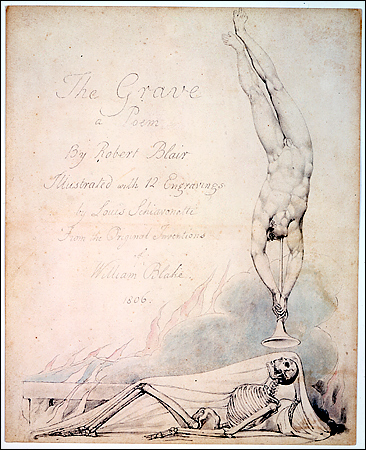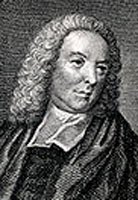|
Robert Blair (poet)
Rev Robert Blair (17 April 1699 – 4 February 1746) was a Scottish poet. His fame rests upon his poem ''The Grave'', which, in a later printing was illustrated by William Blake. Biography He was the eldest son of the Rev. Robert Blair, one of the king's chaplains, and was born at Edinburgh. He was educated at the University of Edinburgh and in the Netherlands, and in 1731 was appointed minister of Athelstaneford in East Lothian. In 1738, he married Isabella, daughter of Professor William Law, with whom he had six children. His family's wealth gave him leisure for his favourite pursuits: gardening and the study of English poets. Blair published only three poems. One was a commemoration of his father-in-law and another was a translation. His reputation rests entirely on his third work, ''The Grave'' (1743), which is a poem written in blank verse on the subject of death and the graveyard. It is much less conventional than its gloomy title might lead one to expect. Its religious ... [...More Info...] [...Related Items...] OR: [Wikipedia] [Google] [Baidu] |
Edinburgh
Edinburgh ( ; gd, Dùn Èideann ) is the capital city of Scotland and one of its 32 Council areas of Scotland, council areas. Historically part of the county of Midlothian (interchangeably Edinburghshire before 1921), it is located in Lothian on the southern shore of the Firth of Forth. Edinburgh is Scotland's List of towns and cities in Scotland by population, second-most populous city, after Glasgow, and the List of cities in the United Kingdom, seventh-most populous city in the United Kingdom. Recognised as the capital of Scotland since at least the 15th century, Edinburgh is the seat of the Scottish Government, the Scottish Parliament and the Courts of Scotland, highest courts in Scotland. The city's Holyrood Palace, Palace of Holyroodhouse is the official residence of the Monarchy of the United Kingdom, British monarchy in Scotland. The city has long been a centre of education, particularly in the fields of medicine, Scots law, Scottish law, literature, philosophy, the sc ... [...More Info...] [...Related Items...] OR: [Wikipedia] [Google] [Baidu] |
Graveyard Poets
The "Graveyard Poets", also termed "Churchyard Poets", were a number of pre-Romantic poets of the 18th century characterised by their gloomy meditations on mortality, "skulls and coffins, epitaphs and worms" elicited by the presence of the graveyard. Moving beyond the elegy lamenting a single death, their purpose was rarely sensationalist. As the century progressed, "graveyard" poetry increasingly expressed a feeling for the " sublime" and uncanny, and an antiquarian interest in ancient English poetic forms and folk poetry. The "graveyard poets" are often recognized as precursors of the Gothic literary genre, as well as the Romantic movement. Overview The Graveyard School is an indefinite literary grouping that binds together a wide variety of authors; what makes a poem a "graveyard" poem remains open to critical dispute. At its narrowest, the term "Graveyard School" refers to four poems: Thomas Gray's " Elegy Written in a Country Churchyard", Thomas Parnell's "Night-Piece on De ... [...More Info...] [...Related Items...] OR: [Wikipedia] [Google] [Baidu] |
18th-century Ministers Of The Church Of Scotland
The 18th century lasted from January 1, 1701 ( MDCCI) to December 31, 1800 ( MDCCC). During the 18th century, elements of Enlightenment thinking culminated in the American, French, and Haitian Revolutions. During the century, slave trading and human trafficking expanded across the shores of the Atlantic, while declining in Russia, China, and Korea. Revolutions began to challenge the legitimacy of monarchical and aristocratic power structures, including the structures and beliefs that supported slavery. The Industrial Revolution began during mid-century, leading to radical changes in human society and the environment. Western historians have occasionally defined the 18th century otherwise for the purposes of their work. For example, the "short" 18th century may be defined as 1715–1789, denoting the period of time between the death of Louis XIV of France and the start of the French Revolution, with an emphasis on directly interconnected events. To historians who expand ... [...More Info...] [...Related Items...] OR: [Wikipedia] [Google] [Baidu] |
Alumni Of The University Of Edinburgh
This is a list of notable graduates as well as non-graduate former students, academic staff, and university officials of the University of Edinburgh in Scotland. It also includes those who may be considered alumni by extension, having studied at institutions that later merged with the University of Edinburgh. The university is associated with 19 Nobel Prize laureates, three Turing Award winners, an Abel Prize laureate and Fields Medallist, four Pulitzer Prize winners, three Prime Ministers of the United Kingdom, and several Olympic gold medallists. Government and politics Heads of state and government United Kingdom Cabinet and Party Leaders Scottish Cabinet and Party Leaders Current Members of the House of Commons * Wendy Chamberlain, MP for North East Fife * Joanna Cherry, MP for Edinburgh South West * Colin Clark, MP for Gordon * Anneliese Dodds, MP for Oxford East * Kate Green, MP for Stretford and Urmston * John Howell, MP for Henley * Neil Hudson, M ... [...More Info...] [...Related Items...] OR: [Wikipedia] [Google] [Baidu] |
18th-century Scottish Poets
The 18th century lasted from January 1, 1701 ( MDCCI) to December 31, 1800 ( MDCCC). During the 18th century, elements of Enlightenment thinking culminated in the American, French, and Haitian Revolutions. During the century, slave trading and human trafficking expanded across the shores of the Atlantic, while declining in Russia, China, and Korea. Revolutions began to challenge the legitimacy of monarchical and aristocratic power structures, including the structures and beliefs that supported slavery. The Industrial Revolution began during mid-century, leading to radical changes in human society and the environment. Western historians have occasionally defined the 18th century otherwise for the purposes of their work. For example, the "short" 18th century may be defined as 1715–1789, denoting the period of time between the death of Louis XIV of France and the start of the French Revolution, with an emphasis on directly interconnected events. To historians who expand t ... [...More Info...] [...Related Items...] OR: [Wikipedia] [Google] [Baidu] |
1746 Deaths
Events January–March * January 8 – The Young Pretender Charles Edward Stuart occupies Stirling, Scotland. * January 17 – Battle of Falkirk Muir: British Government forces are defeated by Jacobite forces. * February 1 – Jagat Singh II, the ruler of the Mewar Kingdom, inaugurates his Lake Palace on the island of Jag Niwas in Lake Pichola, in what is now the state of Rajasthan in northwest India. * February 19 – Brussels, at the time part of the Austrian Netherlands, surrenders to France's Marshal Maurice de Saxe. * February 19 – Prince William, Duke of Cumberland, issues a proclamation offering an amnesty to participants in the Jacobite rebellion, directing them that they can avoid punishment if they turn their weapons in to their local Presbyterian church. * March 10 – Zakariya Khan Bahadur, the Mughal Empire's viceroy administering Lahore (in what is now Pakistan), orders the massacre of the city's Sikh people. April–Ju ... [...More Info...] [...Related Items...] OR: [Wikipedia] [Google] [Baidu] |
1699 Births
Events January–March * January 5 – A violent Java earthquake damages the city of Batavia on the Indonesian island of Java, killing at least 28 people * January 20 – The Parliament of England (under Tory dominance) limits the size of the country's standing army to 7,000 'native born' men; hence, King William III's Dutch Blue Guards cannot serve in the line. By an Act of February 1, it also requires disbandment of foreign troops in Ireland. * January 26 – The Republic of Venice, Polish–Lithuanian Commonwealth and Holy Roman Empire sign the Treaty of Karlowitz with the Ottoman Empire, marking an end to the major phase of the Ottoman–Habsburg wars. The treaty marks a major geopolitical shift, as the Ottoman Empire subsequently abandons its expansionism and adopts a defensive posture while the Habsburg monarchy expands its influence. * February 3 – The first paper money in America is issued by the colony of Massachusetts, to pay its soldiers fighting against Queb ... [...More Info...] [...Related Items...] OR: [Wikipedia] [Google] [Baidu] |
Scottish Literature
Scottish literature is literature written in Scotland or by List of Scottish writers, Scottish writers. It includes works in Scottish English, English, Scottish Gaelic language, Scottish Gaelic, Scots language, Scots, Brythonic languages, Brythonic, French language, French, Latin language, Latin, Norn language, Norn or other languages written within the modern boundaries of Scotland. The earliest extant literature written in what is now Scotland, was composed in Brythonic speech in the sixth century and has survived as part of Welsh-language literature, Welsh literature. In the following centuries there was literature in Latin, under the influence of the Catholic Church, and in Old English, brought by Angles, Anglian settlers. As the state of Alba developed into the kingdom of Scotland from the eighth century, there was a flourishing literary elite who regularly produced texts in both Gaelic and Latin, sharing a common literary culture with Ireland and elsewhere. After the David ... [...More Info...] [...Related Items...] OR: [Wikipedia] [Google] [Baidu] |
Luigi Schiavonetti
Luigi Schiavonetti (1 April 1765 – 7 June 1810) was an Italian reproductive engraver and etcher. Life Luigi Schiavonetti was born at Bassano in Venetia. He was the maternal nephew of Teodoro Viero. After having studied art for several years he was employed by Testolini, an engraver of very indifferent abilities, to execute imitations of Bartolozzi's works, which he passed off as his own. In 1790, Testolini was invited by Bartolozzi to join him in England, and, it having been discovered that Schiavonetti, who accompanied him, had executed the plates in question, he was employed by Bartolozzi and became an eminent engraver in both the line and the stipple manner. Among his early works are four plates of subjects from the French Revolution, after Peter Paul Benazech. Schiavonetti engraved a drawing of Maria Cosway that her husband, the artist Richard Cosway, had drawn. He also engraved a portrait that Maria Cosway had commissioned that was the first portrait of Napoleon ... [...More Info...] [...Related Items...] OR: [Wikipedia] [Google] [Baidu] |
Robert Cromek
Robert Hartley Cromek (1770–1812) was an English engraver, editor, art dealer and entrepreneur who was most active in the early nineteenth century. He is best known for having allegedly cheated William Blake out of the potential profits of his engraving depicting Chaucer's Canterbury Pilgrims. In the early years of the nineteenth century Cromek had supported Blake, and had engraved Blake's design for Benjamin Heath Malkin's ''A Father's Memoirs of his Child'' in 1806. Cromek later commissioned Blake to illustrate Robert Blair's poem ''The Grave''. Blake had produced the designs, but his sample engraving was considered by Cromek to be too crude to attract subscribers. Cromek then gave the lucrative job of engraving Blake's designs to a rival engraver Luigi Schiavonetti. In response, Blake proceeded to create a self-engraved illustration to Chaucer's ''Canterbury Tales''. Cromek, however, had also given the idea to Blake's friend Thomas Stothard Thomas Stothard (17 August 1 ... [...More Info...] [...Related Items...] OR: [Wikipedia] [Google] [Baidu] |
Blank Verse
Blank verse is poetry written with regular metrical but unrhymed lines, almost always in iambic pentameter. It has been described as "probably the most common and influential form that English poetry has taken since the 16th century", and Paul Fussell has estimated that "about three quarters of all English poetry is in blank verse". The first known use of blank verse in English was by Henry Howard, Earl of Surrey in his translation of the '' Æneid'' (composed c. 1540; published posthumously, 1554–1557). He may have been inspired by the Latin original since classical Latin verse did not use rhyme, or possibly he was inspired by Ancient Greek verse or the Italian verse form of '' versi sciolti'', both of which also did not use rhyme. The play ''Arden of Faversham'' (around 1590 by an unknown author) is a notable example of end-stopped blank verse. History of English blank verse The 1561 play '' Gorboduc'' by Thomas Norton and Thomas Sackville was the first English pla ... [...More Info...] [...Related Items...] OR: [Wikipedia] [Google] [Baidu] |
Kingdom Of Scotland
The Kingdom of Scotland (; , ) was a sovereign state in northwest Europe traditionally said to have been founded in 843. Its territories expanded and shrank, but it came to occupy the northern third of the island of Great Britain, sharing a land border to the south with England. It suffered many invasions by the English, but under Robert the Bruce it fought a successful War of Independence and remained an independent state throughout the late Middle Ages. Following the annexation of the Hebrides and the Northern Isles from Norway in 1266 and 1472 respectively, and the final capture of the Royal Burgh of Berwick by England in 1482, the territory of the Kingdom of Scotland corresponded to that of modern-day Scotland, bounded by the North Sea to the east, the Atlantic Ocean to the north and west, and the North Channel and Irish Sea to the southwest. In 1603, James VI of Scotland became King of England, joining Scotland with England in a personal union. In 1707, during the reign ... [...More Info...] [...Related Items...] OR: [Wikipedia] [Google] [Baidu] |







